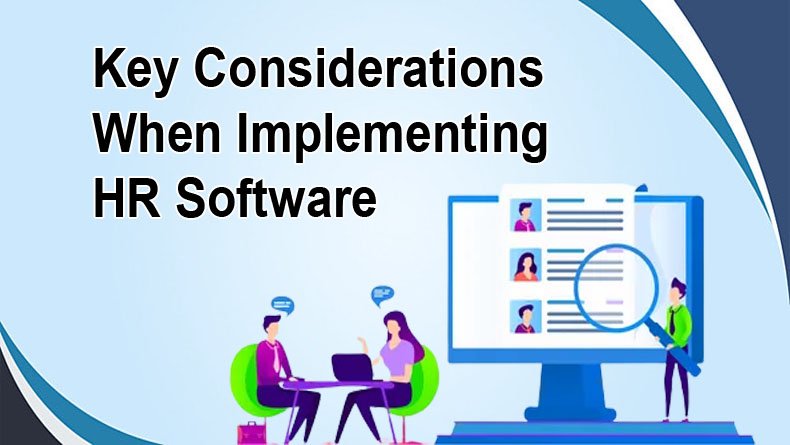HR software has revolutionized the way businesses manage their human resources processes. The days are gone when the record is manually keeping and complex spreadsheets were used. HR software are used to design, establish and manage responsibilities. In other words, HR software acts as the left-hand of a HR. Because HR have to manage all responsibilities such as employee information management and document routing.
As we all know, companies’ success is based on their efficient plans and on their management skills. So, these software help to make plans for the future, organize everything and assign funds. It helps to make a strong and competent company. So many HR software are accessible now, like Workforce Now and Paycom you can split tasks for HR’s. In this article, we will discuss the key consideration to implementing HR software.
How HR Software Benefits our Business?
HR software benefits our business in numerous ways:
Cost- And Time-Saving
HR software automates many time-consuming HR tasks such as staff processing, attendance tracking, and employee onboarding. It reduces the need for manual data entry and paperwork, saving time and reducing the chance of errors. This can lead to cost savings by reducing the need for additional staff or outsourcing HR functions.
Enhanced Precision
HR software helps in maintaining accurate and up-to-date employee information. It can also generate compliance reports and assist with legal compliance, ensuring that our business follows all relevant labor laws and regulations.
Optimizing Data Management
HR software provides a centralized and secure place to store and manage employee data such as personal information, performance reviews, and training records. This allows for easy access to information when needed and helps in making informed decisions about employee performance and development.
Improved Collaboration and Communication
HR software often includes features such as employee self-service portals and communication tools that enable better communication and collaboration among employees and HR departments. This can improve employee engagement and satisfaction.
Key Considerations When Implementing HR Software

Here we mentioned the key consideration that you should focus before implementing any HR software:
Compatibility
Ensure that the software you choose is compatible with your existing systems, such as your payroll software or time-tracking system. The program needs to work with the other tools you use and your current IT setup. Data duplication, mistakes, and other integration problems may result from the software’s inability to integrate with your existing systems. It can also have an effect on productivity and increase the time needed to finish HR tasks.
Options for Integration
Consider whether the software can integrate with other systems and tools you currently use, such as performance management software, recruitment tools, or applicant tracking systems. This will enable a seamless flow of information across different HR functions. Ensure the HR software can seamlessly integrate with your existing systems, such as accounting software or project management tools. Integration avoids duplication of work and facilitates cohesive operations across departments.
Cost-Effectiveness
Take into account the software’s long-term advantages as well as its initial price. Examine the pricing scheme, taking into account any extra charges for ongoing support, upgrades, or supplemental features. Make sure the software offers enough value to make the purchase worthwhile. To assist you and your team in swiftly becoming up to speed, look for software vendors who give thorough training and support. This will guarantee that you are making the most of the software’s capabilities and resolving any problems that could develop.
Ensuring The Future
Make sure that the HR software is compliant with relevant employment laws, regulations, and data privacy requirements. This is particularly important if you operate in multiple authorities or deal with sensitive employee data. Consider whether the software can adapt and evolve along with the changing needs of your organization and the HR industry as a whole. This will help you avoid the need for constant software replacements or major upgrades in the future.
Identify Your Needs and Customization
Before selecting a HR software, identify your organization’s specific requirements. Examine the features you want, such as payroll, performance management, and recruiting, and make sure the program satisfies your particular requirements. Try to choose the software that can be easily customized to meet your needs and workflows. This will help you to modify the software that can be easily fit to your organization’s unique requirements.
Scalability
Consider your organization’s growth potential and whether the HR software can scale and adapt to your changing requirements. It should accommodate future workforce expansion and increasing complexities without compromising its efficiency. So, make sure that the software you choose can grow with your organization. As your business expands or your HR needs change, the software should be able to accommodate the increased demands.
User-Friendliness
Look for an HR software that is spontaneous and user-friendly, enabling easy implementation by your HR team and employees. A complex system may decrease productivity and cause resistance during application. Data security is crucial when handling sensitive employee information. Ensure the HR software offers strong security measures, such as data encryption, user access controls, and compliance with relevant regulations like GDPR or CCPA.
Conclusion
In conclusion, HR software is transforming the way organizations manage their human resources, offering a range of benefits, from automating administrative tasks to empowering strategic decision-making. By considering your organization’s needs, scalability, integration capabilities, user-friendliness, and data security, you can implement an HR software solution that elevates your HR operations and initiatives overall organizational success. Software should be compatible with your existing IT infrastructure and tools to avoid data duplication, errors, and other integration issues. This can negatively impact productivity and HR task completion time. The program must work flawlessly with your existing tools and IT setup to minimize these issues and ensure a smooth workflow.


